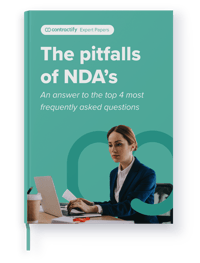The top 4 frequently asked questions about NDAs
NDAs (Non-Disclosure Agreements) are gradually becoming the norm when you enter into commercial discussions with a potential customer or supplier. If you want to know what to consider when signing a Non-Disclosure Agreement and how to follow up on an NDA, then this blog will certainly help you on your way.
1. Can you just sign a non-disclosure agreement?
We always recommend that you read the NDA thoroughly before signing it. Some NDAs contain exclusivity clauses. This clause prohibits you from working or even talking with the competitors of your customer or prospect. If you sign the NDA without being aware of the exclusivity, it will be difficult to reverse this later. It is therefore best to work with a central person in the organization who knows what is acceptable and what is not. This does not have to be a company lawyer, but someone with knowledge of NDAs, such as a contract manager.
2. Can you sign an NDA last minute?
As with any contract, it is far from ideal to sign a Non-Disclosure Agreement last minute. If there is no other way, you can go one of two ways:
- you push your own signed NDA forward or
- you quickly delete what you do not agree with, indicate in the margin what you have deleted, and sign that version.
One of the pitfalls we often encounter is that an NDA has already been signed with a company. Often, people within a company are unaware that an NDA had already been signed one or more years earlier, and is still active. This happens particularly often when working with international groups as a counterparty. If, for example, an NDA has already been signed with the sister company or the head office, then this confidentiality agreement is valid for all the entities of the group. This immediately brings us to the next question.
3. What is the duration of a Non-Disclosure Agreement?
The duration of an NDA depends on the way in which the agreement has been concluded. As with DPAs, this can happen in three ways:
- The NDA clauses are incorporated in the general conditions.
The Non-Disclosure Agreement is activated as soon as you start working together. - The NDA is a separate agreement with the other party and is not linked to any other existing agreement.
The NDA has its own start and end date. - The NDA is an addendum to an existing contract and is linked to it.
The NDA and the original contract run for the same period. Often, however, the Non-Disclosure Agreement remains active for up to five years after the other contract is terminated. This is a lot harder to manage, but not impossible if you use the right tool.
4. How do you sign and manage NDAs efficiently?
To increase efficiency and maintain an overview, you need to know at all times which companies you have an NDA with and who is in internal contact with that customer or supplier. If you keep contracts and NDAs in Excel or a shared drive (e.g. Sharepoint, OneDrive, Google Drive etc.), not only does this require a lot of work, but the margin of error is also considerably larger. For signing and follow-up, it is therefore best to use a tool that meets the necessary requirements for NDAs.

Download the complete guide for more information.



